Created with Sketch.
By
Ezra Dyer
Apr 12, 2017
2017: The year that automation and electric propulsion got affordable and fast. The year of wonderful anachronisms of petroleum power and exhaust volume, dashing fears that the car is evolving into a sterile tool of convenience. Whatever your taste, it is very difficult to buy a bad new car. And yet, some cars were more excellent than others—indeed, better than all the rest. Thus, we are compelled to select the special vehicles, ones that, between gleeful corners, point toward a future where the car as we know it remains an essential technology.
Advertisement – Continue Reading BelowAdvertisement – Continue Reading Below
Car of the Year: Chevrolet Bolt
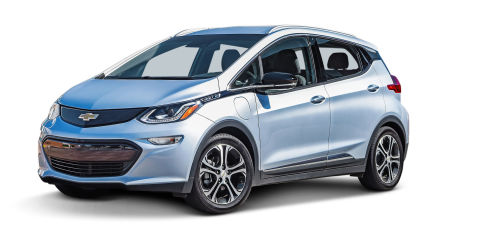
On specs alone, the Chevy Bolt looks like the Car of the Year. Without hyperbole, you can say that it fundamentally changes the economics of electric cars. To surpass the Bolt’s 238-mile range, you’d need to spend more than twice as much money for a Tesla Model S 75. No other car at the Bolt’s $30,000 base price ($37,495, minus the $7,500 tax credit) comes anywhere near its range or power. But plenty of cars look great in theory and disappoint in practice. We needed to drive it. So I got on a flight to Atlanta to rendezvous with one of the first Bolts on the East Coast.
Parked by itself in a cavernous garage, the Bolt looks small. But it’s one of those cars that crams inordinate interior space into a tight wrapper—the interior is plenty spacious for four adults, and the high seating position mimics a crossover rather than a wagon. This makes sense, since you’re sitting atop a big ol’ battery, 288 lithium-ion cells that store a collective 60 kilowatt-hours of energy. The Bolt is a clean-sheet design, a car built around its battery. The photographer and I head into traffic. I execute a full-throttle merge that snaps both our heads back, the Bolt’s front tires clawing at the pavement. “I wasn’t expecting all that!” he says. “A little electric hatchback that takes off like an Audi S4.” It’s not that fast, but the Bolt’s 200 horsepower and 266 lb-ft of torque put it in the same league as compact bottle rockets like the Volkswagen GTI. Except, with no gears to shift and instant torque, the Bolt feels more immediately quick. This kind of acceleration is going to surprise people.
Related Story
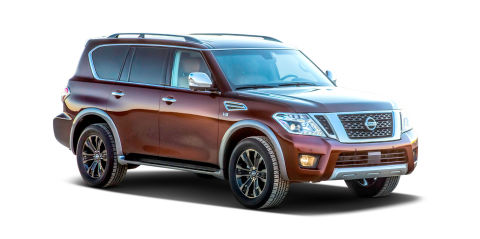
If you want to quickly ascertain whether you’re looking at a crossover or a proper SUV, check the front overhang. Crossovers are based on front-wheel-drive sedans and have lots of body in front of the tires. SUVs have trim overhangs, along with a beefy tow rating, and probably a lowrange transfer case. Of course, you needn’t always look for a tell. If you ever find yourself gazing skyward to find the door handle, you’re looking at an SUV.
Infiniti’s QX80 meets those requirements but carries the same caveat as a Range Rover—with a price that can top $90,000, it ought to be as wonderful as it is. And for that reason, we’ll take the QX’s Nissan cousin, the new Armada. It’s significantly less expensive ($45,995), yet offers most of the equipment that makes the Infiniti appealing, along with a better-looking front end. The Armada outmuscles domestic SUVs like the GMC Yukon XL with a 390-hp V-8 and seven-speed transmission, and its auto-leveling rear suspension helps enable an 8,500-pound tow rating. The interior isn’t as drenched in luxury as the QX, but it’s not too far off, either.
In all, the Armada delivers a luxury-SUV experience at a Nissan price. It’s the best example this year from a category that evolves slowly and is ceding buyers to the crossover. We’ll be watching next year to see whether the Land Rover Discovery restores glory to the name, and if Ford finally overhauls the Expedition. Until then, for those who still need three rows of seats and low-range four-wheel drive, the new Armada does it best.
Advertisement – Continue Reading Below
Concept Car of the Year: Volkswagen I.D. Buzz
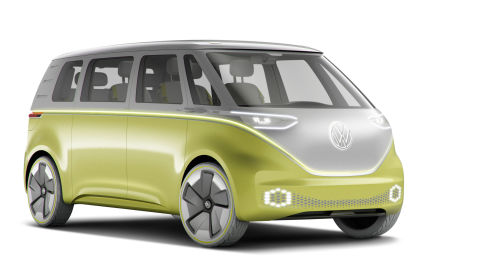
No matter what else is unveiled in 2017, this will remain the concept that most needs to be built. Why? First, nobody sells a mainstream electric minivan. So, duh, get there first. Second, VW needs this—not just for sales, but for image. Its emissions scandal tainted diesel in the United States, so it is VW’s duty to go all-out to remind its customers of the counterculture good ol’ days, when its cackling little buses were the quintessential expression of disdain for The Man, armed conflict, and your dad’s expectation that you’d join the law firm, not become a compost farmer upstate. After time spent in the wrong, it’s time for VW to channel some Cheech and Chong.
FLEXIBLE POWER: The I.D. could be either rear-wheel drive or all-wheel drive. The AWD configuration has 369 horsepower and a zero-to-60 time of 5.0 seconds. That compares favorably to the original buses, some of which began a zero-to-60 run in 1973 and are still trying to get there.
NICE RANGE: The I.D.’s biggest battery pack, at 111 kilowatthours of capacity, would top anything currently on the market. Its predicted range, 270 miles, would allow for highway trips, given that the battery can absorb an 80 percent charge in 30 minutes. It can also charge inductively, if you trust that voodoo.
FULL AUTONOMY: No, you’re not hallucinating: The steering wheel really does retract into the dashboard. This is I.D. Pilot, a fully autonomous mode that could go into production by 2025. The key hardware is laser scanners that deploy from the roof. Somewhat less crucial: The interior lights also switch from white to warm mood lighting.
AUGMENTED REALITY: No, you’re not hallucinating (Part 2): Directions and other information are projected in an augmented-reality overlay that appears as virtual images out ahead of the car. But if reality is only a construction, is it even possible for it to be augmented, or is that just more reality, man?
Minivan of the Year: Chrysler Pacifica
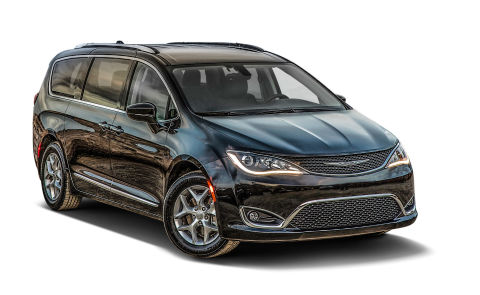
Advertisement – Continue Reading Below
Set the world’s biggest car companies to the task of harmonious family transport and certain commonalities emerge: a V-6 lodged in a stubby nose, disappearing third-row seats, lots of cup holders. But after those requisites, manufacturers distinguish themselves in ways large and small. Toyota’s Sienna has a new 296-hp V-6 and optional all-wheel drive to challenge the SUV and crossover hegemony. The Kia Sedona bets on styling that says, “Maybe I’m an SUV, but with sliding doors.” But minivans are like trucks or sports cars in that decades of continuous development confer a real advantage. While the Chrysler Pacifica takes its name from a discontinued crossover, the vehicle itself is part of a lineage that goes back to the eighties. Over three decades, Chrysler has refined the category it created, arriving at the current standard for minivan excellence. For under $30,000, the Pacifica looks sleek and low-slung without committing the unforgivable minivan sin of trying too hard. It steals Honda’s best contribution to minivans with an optional built-in vacuum. There’s a new plug-in-hybrid version with 33 miles of electric range. But the killer feature is the Stow ‘n Go seats. Other vans have disappearing third rows, but the Pacifica can hide the second row, too, instantly transforming from luxury people-mover into capacious cargo van. You’re not supposed to feel particularly good about buying a minivan—cue Cheap Trick’s “Surrender”—but the Pacifica aspires to do you proud.
Crossover of the Year: Jaguar F-Pace
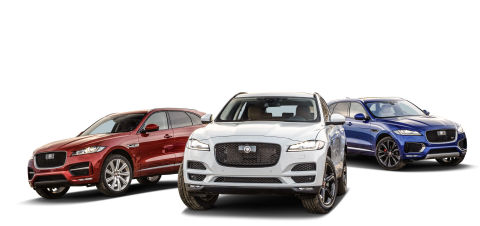
Two decades ago, the truck-based SUV was the dominant mode of anti-minivan family transportation. That movement gave way to the crossover, which offers the image of an SUV with the driving behavior and fuel economy of a sedan. Some are specialized toward an off-road bent, like the Jeep Cherokee Trailhawk and the GMC Acadia All Terrain. Others, like the Audi Q7, Volvo XC90, and Mazda CX-9, stress upscale interiors. The performance crowd is led by the pricey and powerful Porsche Macan and AMG-flavored Mercedes-Benzes. The Subaru Outback stands for iconoclastic value, while the Nissan Murano and Lexus RX express futurism. The Tesla Model X is in its own gullwinged, electric class of one.
Yes, everyone sells a crossover, so we’ll cut right to the one we covet: the Jaguar F-Pace. It’s less than you’d expect (starting at just over $40,000), and it comes with a thrifty diesel or a supercharged V-6 that makes up to 380 horsepower. The rear-wheel-drive platform gives it agile handling. And it just looks good, bringing charisma to a type of vehicle that doesn’t usually offer much. The F-Pace is Jaguar’s best-selling vehicle, and it should do for Jag what the Cayenne did for Porsche: help a performance-oriented company stay relevant for years to come.
Sedan of the Year: Mazda6
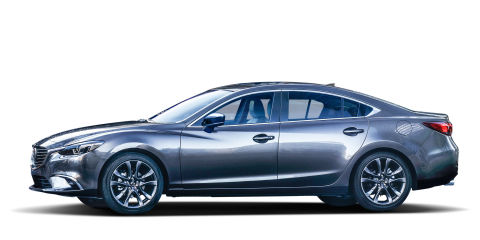
Advertisement – Continue Reading Below
Sedans have a tough mission brief. We expect heroic fuel economy, comfortable seating for five, and handling like that of a Lotus. And it should be a good value, something that will confer an air of erudition upon its driver. With cup holders in just the right spots.
Competition to meet these criteria has resulted in industry-wide quality. Small sedans like the Chevy Cruze and the Hyundai Elantra Sport pack in luxury features for less than $30,000. You can cover a lot of miles without detecting the faintest sense of cheapness through your heated leather seat. The Subaru Legacy is an intriguing outlier, a big car that hews to modest pricing (less than $23,000) with standard all-wheel drive and horizontally opposed engines. You can see why Subaru’s been on a hellacious sales roll, setting new records each of the past eight years. If you seek driver engagement, you can get a manual or an optional V-6 in the Honda Accord, a vehicle clearly designed by people who love driving. The Jaguar XE and XF are otherwise wonderful cars let down by less-than-premium materials. But Jaguar could raise its prices and still undercut German competitors like the new Mercedes-Benz E300, which looks and drives like a scaled-down S-Class and is priced accordingly.
Related Story
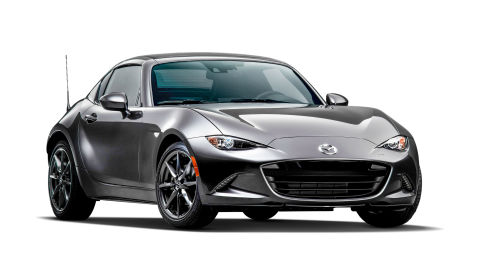
Advertisement – Continue Reading Below
What is a sports car? Well, we’d say it’s any car that overtly prioritizes fun over practicality. Sports cars have a selfish streak. The Dodge Challenger SRT Hellcat is a sports car, albeit one that’s big enough to serve as a garage for its tiny Italian cousin, the exquisite Alfa Romeo 4C. The Audi TTS is a sports car, because it does the same things as an S3 sedan but with more style and less utility. The BMW M2 and Infiniti Q60 Red Sport 400 are sports cars—sexy, refined coupes with an overabundance of turbocharged horsepower. The Porsche 718 Boxster S has no room for golf clubs, a serious mark of sports-car credibility.
Speaking of Porsches, sports cars can be expensive. But they don’t have to be, a fact underscored by our winner, the Mazda MX-5 Miata RF. “RF” stands for “Retractable Fastback,” Mazda’s term for the power-operated hideaway hardtop. Hit a button and the rear deck slides back, the roof disappears, and the car reassembles itself. It’s an amazing piece of engineering for a car that costs $32,000, offering both exhilarating open-air corner carving and (relatively) serene top-up highway cruising. If you’re looking for a sports car with just enough of a hint of practicality, this is it.
Pickup Truck of the Year: Ford Raptor
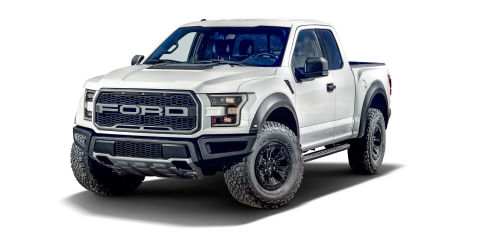
The pickup is the best-selling vehicle in America. Has been for decades. And it’s easy to see why. A single vehicle that can be your family sedan, your tow vehicle, your delivery van, and maybe even your sports car is hugely appealing. The resulting demand has created relentless competition, which means it’s hard to find a bad truck these days. The midsize Toyota Tacoma and Chevy Colorado can perform like a full-size (including price, unfortunately). The new Honda Ridgeline is for pragmatists, with a lockable cubby under the bed. The Ford Super Duty line, with aluminum bodies and an optional diesel with 925 lb-ft of torque, will tow any tree stump. And the Ram Power Wagon keeps upping its heavy-duty, factory-winch-having, off-roader game, even though it’s the only one playing it.
Related Story
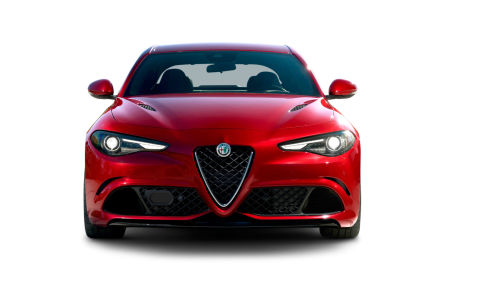
Credit the 1968 Mercedes-Benz 300SEL 6.3 as the progenitor of the modern super sedan. Underneath its sedate exterior was the huge V-8 from the 600 limo, endowing it with sportscar performance in a stealth package. That formula endures today in cars that can top out above 200 mph, but cruise comfortably and anonymously in traffic. We tested an Audi S8 that ran an 11.7-second quarter-mile, 0.2 seconds faster than the Corvette Z51 we ran at the same strip. And the S8 isn’t even the quickest big sedan. The Dodge Charger SRT Hellcat, surely the scariest family car since the Munster Koach, will casually lay rubber at 45 mph.
But the Hellcat is an unapologetic muscle car: accurate as a cannonball, with a 707-hp V-8 to outrun anything as long as the road is straight and wide. The Cadillac CTS-V is a model of finesse in comparison, with 640 horsepower stuffed into a chassis that’s built to lap road courses all day long. Cadillac sees the CTS-V as the ultimate sedan, an attitude underscored by a price that can easily stray way above $100,000. You can get super-sedan thrills for less money than that. Specifically, for $73,595, the price of an Alfa Romeo Giulia Quadrifoglio (kwa-dra-fol-eeoh).
This car, we are happy to say, sets the new standard, and not because it puts down superlative numbers—which it does, with zero-to-60 in less than four seconds and a 191-mph top speed. No, the Alfa’s secret is that it’s always rewarding, even at sane speeds. The twin-turbo V-6 shrieks and howls like the three-quarters of a Ferrari V-8 it is. There is absolutely no slack in the steering, with instant responses somehow coexisting with excellent high-speed stability. The Giulia is beautiful, too, fenders drawn tight over big phone-dial wheels. The best part is, if you can’t afford the flagship Quadrifoglio, the base Giulia—zero-to-60 in 5.5 seconds—starts at less than $40,000.
More from Popular Mechanics:<div
Related posts:
No related posts.

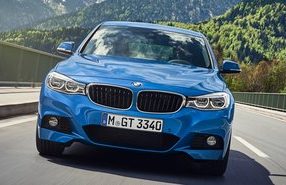
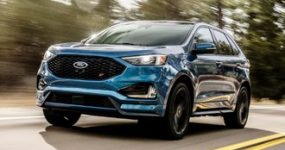

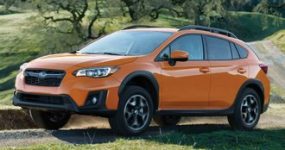
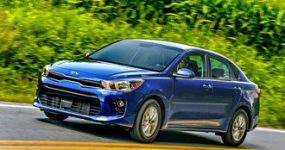
Recent Comments